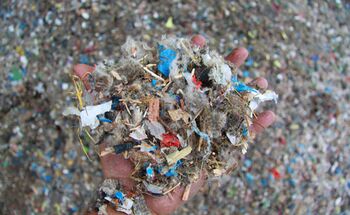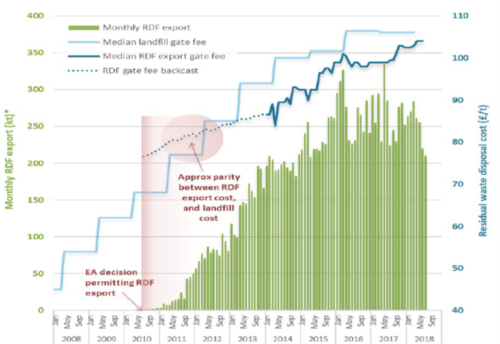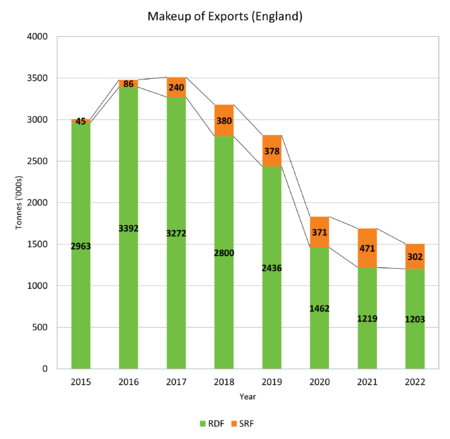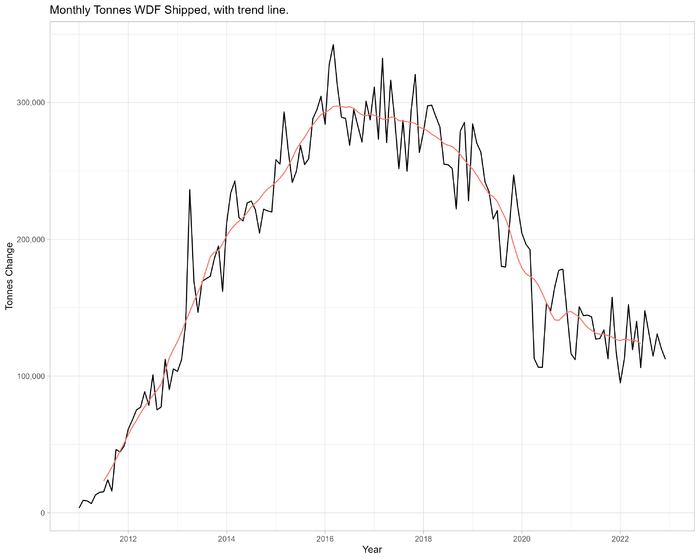Refuse Derived Fuel: Difference between revisions
| Line 157: | Line 157: | ||
===Exporters=== | ===Exporters=== | ||
Exporters from the UK during the years 2017, 2018, 2019 and Q1/Q2 2020 | Exporters from the UK during the years 2017, 2018, 2019 and Q1/Q2 2020. | ||
{|class = "wikitable sortable" | {|class = "wikitable sortable" | ||
Revision as of 06:59, 20 April 2022
A type of Waste Derived Fuel, Refuse Derived Fuel or RDF has been prepared by a treatment process to produce a broad specification fuel, which is still considered to be a waste, that can be used by an EfW plant supplied under a Fuel Supply Agreement. The specification will depend upon the plant to be used, but typically at the most basic level will have had metals and inert materials removed, removal of some recyclables and limited shredding/bag splitting. More refined RDF will have had drying, shredding to a uniform size and Moisture Content reduction. At the very high end of production the RDF will move towards being a Solid Recovered Fuel (SRF).

Context
A type of Waste Derived Fuel, Refuse Derived Fuel or RDF has been prepared by a treatment process to produce a broad specification fuel, which is still considered to be a waste, that can be used by an EfW plant supplied under a Fuel Supply Agreement. The specification will depend upon the plant to be used, but typically at the most basic level will have had metals and inert materials removed, removal of some recyclables and limited shredding/bag splitting. More refined RDF will have had drying, shredding to a uniform size and Moisture Content reduction. At the very high end of production the RDF will move towards being a Solid Recovered Fuel (SRF).
Composition of Refuse Derived Fuel
We have pulled together a number of specification (spec) sheets to produce give an overall feel for the spec of Refuse Derived Fuel and Solid Recovered Fuel, as shown in the table below. In reality the spec is usually very tightly controlled by the receiving plant.
| Measure | Units | Residual Waste[1] | RDF | SRF |
|---|---|---|---|---|
| Net Calorific Value | MJ/kg (as received) | 9 - 15 | 10 - 15 | >18.5 |
| Moisture | wt% (dry basis) | 10 - 40 | <20 | <15 |
| Biomass Content[2] | wt% (dry basis) | >45 | >65 | >65 |
| Ash Content | wt% (dry basis) | 10 - 30 | <20 | <15 |
| Sulphur | wt% (dry basis) | < 0.85 | <0.5 | <0.5 |
| Nitrogen | wt% (dry basis) | <1.5 | <0.8 | <0.8 |
| Lead | mg/kg | <200 | <100 | <80 |
| Chlorine CI | wt% (dry basis) | <1.2 | <0.6 | <0.6 |
| Zinc[3] | wt% (dry basis) | <0.1 | ||
| Sodium and Potassium[3] | wt% (dry basis) | <0.8 | ||
| Mercury | mg/kg | <2 | <1 | <0.6 |
| Nickel | mg/kg | <200 | <100 | <100 |
| Thallium | mg/kg | <20 | <10 | <10 |
| Ferrous and non-ferrous metals | wt% (dry basis) | <7 | <3 | <1 |
| Non combustible material | wt% (dry basis) | <15 | <10 | <5 |
| Glass | wt% (dry basis) | <5 | <2 | <1 |
| Dust <1mm | wt% (dry basis) | <5 | <5 | <5 |
| Bulk Density (loose) | kg/m3 | 100 - 275 | 100 - 175 | 185 |
| Particle Size (max dimension) | mm | 500 | 300 | <40 |
Background to Export of Refuse Derived Fuel
The movement of RDF from the UK, primarily in the EU, commenced in c.2010 and progressively grew up until around 2016 driven by supply-demand and landfill tax in the UK and the economics and spare capacity of EfW plants in the EU. From around 2017 tonnages for export started to drop, with more pronounced drops from 2018 as the supply-demand patterns changed in the UK, some EU countries started to implement taxation on EfW and the cost and complexities of transportation following Brexit increased. The two charts below show the overall patterns of export:
 |
 |
| CIWM Presidential Report (2018) Showing Grow in RDF and SRF Export[4] | Analysis by Monksleigh of RDF and SRF Exports from England from EA Data |
Moving Refuse Derived Fuel and Solid Recovered Fuel from the UK abroad requires compliance with the Transfrontier Shipment Regulations (TFS) and in simple terms requires an application for movement to be made to the relevant authorities that requires a number of key measures to be satisfied before this can occur.
Annual Export from England
The data shown is for export from England and for Waste Code 19 12 10 - combustible waste (refuse derived fuel) as this is the primary code that covers both RDF and SRF tonnage.
It is important to note that some RDF / SRF is exported under the Waste Code 19 12 12 - other wastes (including mixtures of materials) from mechanical treatment of wastes other than those mentioned in 19 12 11, this code is a catch all, and covers any waste from Mechanical treatment not covered by it's own 19 12 waste code and as such has not been included in the numbers below.
Month on Month Export
The graph shows the monthly shipments of RDF along with a trend line showing the trajectory of export.

Year on Year Differences
<graph>{
"width": 500,
"height": 500,
"data": [
{
"name": "table",
"values": [
{"x": 2012, "y": 758521}, {"x": 2013, "y": 953391},
{"x": 2014, "y": 698508}, {"x": 2015, "y": 549765},
{"x": 2016, "y": 319223}, {"x": 2017, "y": -78564},
{"x": 2018, "y": -277369}, {"x": 2019, "y": -402945},
{"x": 2020, "y": -890878}, {"x": 2021, "y": -318729}
]
}
],
"scales": [
{
"name": "x",
"type": "ordinal",
"range": "width",
"domain": {"data": "table", "field": "x"}
},
{
"name": "y",
"type": "linear",
"range": "height",
"domain": {"data": "table", "field": "y"},
"nice": true
}
],
"axes": [
{"type": "x", "scale": "x"},
{"type": "y", "scale": "y"}
],
"marks": [
{
"type": "rect",
"from": {"data": "table"},
"properties": {
"enter": {
"x": {"scale": "x", "field": "x"},
"width": {"scale": "x", "band": true, "offset": -1},
"y": {"scale": "y", "field": "y"},
"y2": {"scale": "y", "value": 0}
},
"update": {
"fill": {"value": "steelblue"}
}
}
}
]
}</graph> | |||
| Data Table | |||
|---|---|---|---|
| Year | Tonnage Shipped | Increase on Previous | Percentage Change |
| 2011 | 251,451 | - | - |
| 2012 | 1,009,972 | +758,520 | 301.7% |
| 2013 | 1,963,363 | +953,390 | 94.4% |
| 2014 | 2,661,871 | +698,508 | 35.6% |
| 2015 | 3,211,636 | +549,765 | 20.7% |
| 2016 | 3,530,859 | +319,222 | 9.9% |
| 2017 | 3,452,295 | -78,563 | -2.2% |
| 2018 | 3,174,926 | -277,269 | -8.0% |
| 2019 | 2,771,981 | -402,945 | -12.7% |
| 2020 | 1,881,103 | -890,878 | -32.1% |
| 2021 | 1,562,374 | -318,729 | -16.9% |
Exporters
Exporters from the UK during the years 2017, 2018, 2019 and Q1/Q2 2020.
| Company | 2017 | 2018 | 2019 | 2020 |
|---|---|---|---|---|
| ABN Paris SAS | 2,244 | |||
| Andusia Recovered Fuels Ltd | 180,644 | 157,690 | 152,590 | 75,386 |
| Associated Waste Management Ltd | 53,711 | 39,982 | 49,910 | 3,226 |
| Baco-Compak (Norfolk) Ltd | 7,077 | 5,062 | ||
| Bagnall & Morris (Waste Services) Ltd | 17,115 | 18,668 | 9,254 | |
| Bertling Enviro AB | 89,208 | 171,445 | 153,912 | 67,888 |
| Biffa Waste Services Ltd | 463,102 | 358,290 | 315,622 | 73,774 |
| Bywaters (1986) Ltd | 24,789 | |||
| Camreg Ltd | 26,170 | 21,183 | 8,884 | |
| CellMark UK Ltd | 14,231 | 1,956 | ||
| Chambers Waste Management PLC | 24,907 | 2,554 | ||
| Combineering A/S | 4,759 | 13,610 | 6,012 | 1,628 |
| Countrystyle Recycling Ltd | 90,848 | 64,260 | 52,411 | 8,618 |
| Eco-Power Environmental (Hull) Ltd | 3,659 | 3,779 | ||
| EFO AB | 4,932 | 9,835 | 4,778 | |
| FCC Recycling (UK) Ltd | 187,944 | 168,850 | 86,438 | 30,877 |
| Frimstone Ltd | 15,282 | 14,690 | 12,030 | |
| Gemi UK Ltd | 14,025 | |||
| Geminor UK Ltd | 329,069 | 436,586 | 232,567 | 90,361 |
| Greenway Waste Recycling | 77 | |||
| Grundon Waste Management Ltd | 32,412 | 24,854 | 16,729 | |
| Hills Waste Solutions Ltd | 23,573 | 17,276 | 9,082 | 10,147 |
| JBT Waste Services Ltd | 17,864 | 11,826 | ||
| McGrath Bros (Waste Control) Ltd | 73,327 | 29,854 | 34,281 | 7,619 |
| Mid UK Recycling Ltd | 17,419 | 52,481 | 21,887 | |
| N&P Alternative Fuels Ltd | 355,944 | 363,204 | 289,781 | 73,010 |
| N+P Recycling B.V. | 27 | |||
| New Earth Solutions (Canford) Ltd | 45,822 | 30,610 | 34,738 | 5,740 |
| New Earth Solutions (West) Limited T/A Mid UK Recycling | 62,051 | 38,730 | 60,966 | 44,609 |
| Northstone International Ltd | 9,809 | 35,184 | 6,727 | |
| Pericula Ltd | 289 | 1,200 | 3,794 | |
| PM Recycling Ltd | 7,555 | |||
| Powerday PLC | 37,886 | 18,028 | 17,759 | 4,114 |
| Probio Energy Ltd | 94,802 | 143,218 | 167,256 | 62,423 |
| Quercia Ltd | 54,156 | 58,485 | 55,589 | 15,439 |
| REDACTED | 870 | 849 | ||
| Remondis UK Ltd | 5,091 | 16,413 | 1,795 | |
| Renewi UK Services Ltd | 30,053 | 30,693 | ||
| Seneca Environmental Solutions Ltd | 230,049 | 155,215 | 126,137 | 24,504 |
| Shanks Waste Management Ltd | 143,416 | 117,886 | 74,997 | 24,264 |
| Specialised Waste Solutions Ltd | 49 | 170 | ||
| Street Fuel Ltd | 56,041 | 44,128 | 23,594 | 8,449 |
| SUEZ Recycling and Recovery UK Ltd | 428,609 | 322,104 | 280,957 | 94,708 |
| Thanet Waste Services Ltd | 8,471 | 72 | ||
| Totus Environmental Ltd | 47,909 | 63,123 | 34,736 | 9,688 |
| Veolia ES (UK) Ltd | 155,917 | 164,010 | 171,784 | |
| Weir Waste Services Ltd | 13,613 | 1,895 | ||
| West Sussex Britaniacrest Seneca Partnership Ltd | 30,260 | 56,242 | 31,033 |
